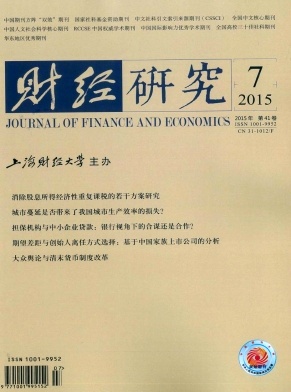货币政策信号、实际干预与企业投资行为
财经研究 2015 年 第 41 卷第 07 期, 页码:
摘要
参考文献
摘要
货币政策对微观企业行为的影响既是宏观经济政策研究关注的话题之一,也是近期财务会计领域研究的新热点。文章结合我国近年来央行信息披露与货币政策调控实践,利用2002年第1季度至2013年第2季度上市公司的平衡面板数据,分析了央行通过信息披露发出的货币政策调控信号以及经济运行中的实际调控政策对微观企业投资行为的影响。研究发现,央行通过信息披露引导微观企业投资行为,实际上依赖于数量型和价格型调控工具的实施,当与实际货币政策一致时,货币政策信号能够有效地引导企业投资行为,而当与实际货币政策不一致时,货币政策信号的调控意义不明显。货币政策调控事件分析也说明货币政策信号与实际政策一致时能够对宏观经济基础起到很好的调控作用,因而应保证货币政策信号的可信性。文章的研究不仅有助于梳理我国货币政策传导机制,拓展和深化央行沟通研究,也为宏观经济政策与微观企业行为研究提供了新视角。
[1]卞志村,张义.央行信息披露、实际干预与通胀预期管理[J].经济研究,2012,(12):15-28.
[2]曾刚,万志宏.中央银行沟通与货币政策:最新实践与启示[J].国际金融研究,2014,(2):11-18.
[3]曾海舰,苏冬蔚.信贷政策与公司资本结构[J].世界经济,2010,(8):17-42.
[4]黄志忠,谢军.宏观货币政策、区域金融发展和企业融资约束[J].会计研究,2013,(1):63-69.
[5]姜国华,饶品贵.宏观经济政策与微观企业行为——拓展会计与财务研究新领域[J].会计研究,2011,(3):9-18.
[6]蒋瑛琨,刘艳武,赵振全.货币渠道与信贷渠道传导机制有效性的实证分析[J].金融研究,2005,(5):70-79.
[7]金中夏,洪浩,李宏瑾.利率市场化对货币政策有效性和经济结构调整的影响[J].经济研究,2013,(4):69-82.
[8]靳庆鲁,孔祥,侯青川.货币政策、民营企业投资效率与公司期权价值[J].经济研究,2012,(5):96-106.
[9]李连发,辛晓岱.银行信贷、经济周期与货币政策调控:1984-2011[J].经济研究,2012,(3):102-114.
[10]李相栋.中央银行沟通及其在美联储应对2007-2009金融危机过程中的应用[J].世界经济研究,2011,(3):40-45.
[11]李云峰.中央银行沟通、实际干预与通货膨胀稳定[J].国际金融研究,2012,(4):15-23.
[12]马草原,李成.国有经济效率、增长目标约束与货币政策超调[J].经济研究,2013,(7):76-89.
[13]穆良平,程均丽.货币政策透明度制度兴起的背景分析[J].金融研究,2004,(5):46-52.
[14]屈文洲,谢雅璐,叶玉妹.信息不对称、融资约束与投资-现金流敏感性[J].经济研究,2011,(6):105-117.
[15]饶品贵,姜国华.货币政策对银行信贷与商业信用互动关系影响研究[J].经济研究,2013,(1):68-81.
[16]盛松成,吴培新.中国货币政策的二元传导机制——“两中介目标,两调控对象”模式研究[J].经济研究,2008,(10):37-51.
[17]王国刚.中国货币政策目标的实现机理分析:2001-2010[J].经济研究,2012a,(12):4-14.
[18]王国刚.中国货币政策调控工具的操作机理:2001-2010[J].中国社会科学,2012b,(4):62-82.
[19]王振山,王志强.我国货币政策传导途径的实证研究[J].财经问题研究,2000,(12):60-63.
[20]魏永芬.关于货币政策透明度问题的研究[J].金融研究,2004,(10):33-39.
[21]徐明东,陈学彬.中国工业企业投资的资本成本敏感性分析[J].经济研究,2012,(3):40-52.
[22]徐亚平.货币政策有效性与货币政策透明制度的兴起[J].经济研究,2006,(8):24-34.
[23]Bernanke B, Gertler M. Inside the black box: The credit channel of monetary policy transmission[J]. Journal of Economic Perspectives, 1995, 9(4): 27-48.
[24]Blinder A, Ehrmann M, Fratzscher M, et al. Central bank communication and monetary policy: A survey of theory and evidence[J]. Journal of Economic Literature, 2008, 46(4): 910-945.
[25]Cleary S, Ovel P P, Raith M. The Ushaped investment curve: Theory and evidence[J]. Journal of Financial and Quantitative Analysis, 2007, 42(1): 1-40.
[26]Issing O. Communication, transparency, accountability: Monetary policy in the twentyfirst century[J]. Federal Reserve Bank of St. Louis Review, 2005, 87(2): 65-83.
[27]Jensen M,Meckling W.Theory of firm:Managerial behavior,agency costs and ownership structure[J].Journal of Financial Economics,1976,3(4):305-360.
[28]Kashyap A K, Stein J C, Wilcox D W. Monetary policy and credit conditions: Evidence from the composition of external finance[J]. American Economic Review, 1993, 83: 78-98.
[29]Kohn D L, Sack B. Central bank talk: Does it matter and why?[R]. Working Paper, 2004.
[30]Kydland F E, Prescott E C. Rules rather than discretion: The inconsistency of optimal plans[J]. Journal of Political Economy, 1977, 85(3): 473-491.
[31]Leary M. Bank loan supply, lender choice, and corporate capital structure[J]. Journal of Finance, 2009, 64(3): 1143-1185.
[32]Myers S C, Majluf N S. Corporate financing and investment decisions when firms have information that investors do not have[J]. Journal of Financial Economics, 1984, 13(2): 187-221.
[33]Nilsen J. Trade credit and the bank lending channel[J]. Journal of Money, Credit and Banking, 2002, 34(1): 226-253.
[34]Richardson S. Overinvestment of free cash flow[J]. Review of Accounting Studies, 2006, 11(2-3): 159-189.
[35]Stigliz J E, Weiss A. Credit rationing in markets with imperfect information[J]. American Economic Review, 1981, 73(3): 393-410.
[36]Tobin J. A general equilibrium approach to monetary theory[J]. Journal of Money, Credit and Banking, 1969, 1(1): 15-29.
[37]Voutsinas K, Werner R A. Credit supply and corporate capital structure: Evidence from Japan[J]. International Review of Financial Analysis, 2011, 20(5): 320-334.
[2]曾刚,万志宏.中央银行沟通与货币政策:最新实践与启示[J].国际金融研究,2014,(2):11-18.
[3]曾海舰,苏冬蔚.信贷政策与公司资本结构[J].世界经济,2010,(8):17-42.
[4]黄志忠,谢军.宏观货币政策、区域金融发展和企业融资约束[J].会计研究,2013,(1):63-69.
[5]姜国华,饶品贵.宏观经济政策与微观企业行为——拓展会计与财务研究新领域[J].会计研究,2011,(3):9-18.
[6]蒋瑛琨,刘艳武,赵振全.货币渠道与信贷渠道传导机制有效性的实证分析[J].金融研究,2005,(5):70-79.
[7]金中夏,洪浩,李宏瑾.利率市场化对货币政策有效性和经济结构调整的影响[J].经济研究,2013,(4):69-82.
[8]靳庆鲁,孔祥,侯青川.货币政策、民营企业投资效率与公司期权价值[J].经济研究,2012,(5):96-106.
[9]李连发,辛晓岱.银行信贷、经济周期与货币政策调控:1984-2011[J].经济研究,2012,(3):102-114.
[10]李相栋.中央银行沟通及其在美联储应对2007-2009金融危机过程中的应用[J].世界经济研究,2011,(3):40-45.
[11]李云峰.中央银行沟通、实际干预与通货膨胀稳定[J].国际金融研究,2012,(4):15-23.
[12]马草原,李成.国有经济效率、增长目标约束与货币政策超调[J].经济研究,2013,(7):76-89.
[13]穆良平,程均丽.货币政策透明度制度兴起的背景分析[J].金融研究,2004,(5):46-52.
[14]屈文洲,谢雅璐,叶玉妹.信息不对称、融资约束与投资-现金流敏感性[J].经济研究,2011,(6):105-117.
[15]饶品贵,姜国华.货币政策对银行信贷与商业信用互动关系影响研究[J].经济研究,2013,(1):68-81.
[16]盛松成,吴培新.中国货币政策的二元传导机制——“两中介目标,两调控对象”模式研究[J].经济研究,2008,(10):37-51.
[17]王国刚.中国货币政策目标的实现机理分析:2001-2010[J].经济研究,2012a,(12):4-14.
[18]王国刚.中国货币政策调控工具的操作机理:2001-2010[J].中国社会科学,2012b,(4):62-82.
[19]王振山,王志强.我国货币政策传导途径的实证研究[J].财经问题研究,2000,(12):60-63.
[20]魏永芬.关于货币政策透明度问题的研究[J].金融研究,2004,(10):33-39.
[21]徐明东,陈学彬.中国工业企业投资的资本成本敏感性分析[J].经济研究,2012,(3):40-52.
[22]徐亚平.货币政策有效性与货币政策透明制度的兴起[J].经济研究,2006,(8):24-34.
[23]Bernanke B, Gertler M. Inside the black box: The credit channel of monetary policy transmission[J]. Journal of Economic Perspectives, 1995, 9(4): 27-48.
[24]Blinder A, Ehrmann M, Fratzscher M, et al. Central bank communication and monetary policy: A survey of theory and evidence[J]. Journal of Economic Literature, 2008, 46(4): 910-945.
[25]Cleary S, Ovel P P, Raith M. The Ushaped investment curve: Theory and evidence[J]. Journal of Financial and Quantitative Analysis, 2007, 42(1): 1-40.
[26]Issing O. Communication, transparency, accountability: Monetary policy in the twentyfirst century[J]. Federal Reserve Bank of St. Louis Review, 2005, 87(2): 65-83.
[27]Jensen M,Meckling W.Theory of firm:Managerial behavior,agency costs and ownership structure[J].Journal of Financial Economics,1976,3(4):305-360.
[28]Kashyap A K, Stein J C, Wilcox D W. Monetary policy and credit conditions: Evidence from the composition of external finance[J]. American Economic Review, 1993, 83: 78-98.
[29]Kohn D L, Sack B. Central bank talk: Does it matter and why?[R]. Working Paper, 2004.
[30]Kydland F E, Prescott E C. Rules rather than discretion: The inconsistency of optimal plans[J]. Journal of Political Economy, 1977, 85(3): 473-491.
[31]Leary M. Bank loan supply, lender choice, and corporate capital structure[J]. Journal of Finance, 2009, 64(3): 1143-1185.
[32]Myers S C, Majluf N S. Corporate financing and investment decisions when firms have information that investors do not have[J]. Journal of Financial Economics, 1984, 13(2): 187-221.
[33]Nilsen J. Trade credit and the bank lending channel[J]. Journal of Money, Credit and Banking, 2002, 34(1): 226-253.
[34]Richardson S. Overinvestment of free cash flow[J]. Review of Accounting Studies, 2006, 11(2-3): 159-189.
[35]Stigliz J E, Weiss A. Credit rationing in markets with imperfect information[J]. American Economic Review, 1981, 73(3): 393-410.
[36]Tobin J. A general equilibrium approach to monetary theory[J]. Journal of Money, Credit and Banking, 1969, 1(1): 15-29.
[37]Voutsinas K, Werner R A. Credit supply and corporate capital structure: Evidence from Japan[J]. International Review of Financial Analysis, 2011, 20(5): 320-334.
引用本文
徐光伟, 孙 铮. 货币政策信号、实际干预与企业投资行为[J]. 财经研究, 2015, 41(7): 0.
导出参考文献,格式为:





 8993
8993  4165
4165

